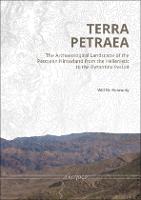Terra Petraea
Author(s)
Kennedy, Will M.
Collection
Knowledge Unlatched (KU)Language
EnglishAbstract
To better understand the ancient Nabataean capital of Petra, it is important to consider its rural surroundings as well. The city's unfavorable geostrategic location makes this already clear: Situated in a deep valley and flanked by high mountain ranges, Petra's urban development was only possible through a well-structured organization of its surrounding landscape.
This study presents a first comprehensive archaeological and culture-historical characterization of the Petraean hinterland and researches overall strategies of the spatial organization of the city's rural environs. Based on an extensive set of archaeological survey data from the Petra region, this study explores a variety of archaeological site types and features diachronically. While the main chronological focus is clearly set on the Nabataean and Roman periods, it also considers the preceding Iron Age and Hellenistic periods, as well as the subsequent Byzantine period.
The aim is to examine rural settlement patterns and subsistence strategies, aspects of rural water management, the extensive infrastructural network, the funerary and religious landscape, the military disposition, as well as the industrial potential of rural Petra. Following a unique landscape archaeological approach, this study provides a differentiated analysis of the various archaeological sites and features for a broad, regional understanding of the Petraean hinterland and offers new insights into the socio-political and administrative, military, economic and infrastructural development of Terra Petraea through time.
Um die antike Nabatäerhauptstadt, Petra, besser verstehen zu können, muss man auch das Umland der Stadt in Betracht ziehen. Allein die geostrategisch ungünstige Lage Petras macht dies schon deutlich: In einem tiefen Tal gelegen und umgeben von steilen Gebirgsketten, war die Entwicklung der Stadt nur durch eine gut funktionierende Organisation der umliegenden Landschaft möglich.
Diese Arbeit untersucht diesen Aspekt näher und legt eine erste, umfassende archäologische und kulturhistorische Charakterisierung des Umlandes von Petra vor und erforscht allgemeine Strategien zur räumlichen Organisation des peträischen Hinterlandes. Sie stützt sich dabei auf extensive archäologische Surveydaten aus der Petra-Region und untersucht eine Vielzahl von archäologischen Fundstellen und Gattungen diachron. Der chronologische Schwerpunkt liegt eindeutig auf der nabatäischen und römischen Periode. Es werden aber auch die vorangehende eisenzeitliche und hellenistische Periode sowie die nachfolgende byzantinische Zeit berücksichtigt.
Ziel ist es, ländliche Siedlungsmuster und Subsistenzstrategien, Aspekte des ländlichen Wassermanagements, das infrastrukturelle Netzwerk, die funeräre und religiöse Landschaft, die militärische Disposition sowie das industrielle Potential des peträischen Umlandes zu untersuchen. Mit einem bisher einzigartigen landschaftsarchäologischen Ansatz, bietet diese Arbeit eine differenzierte Analyse der archäologischen Daten, um ein breites Verständnis der räumlichen Organisation des peträischen Hinterlandes zu ermäglichen. Es sollen dabei neue Erkenntnisse in die sozio-politische und administrative, militärische, wirtschaftliche und infrastrukturelle Entwicklung der Terra Petraea im Laufe der Zeit geboten werden.


 Download
Download